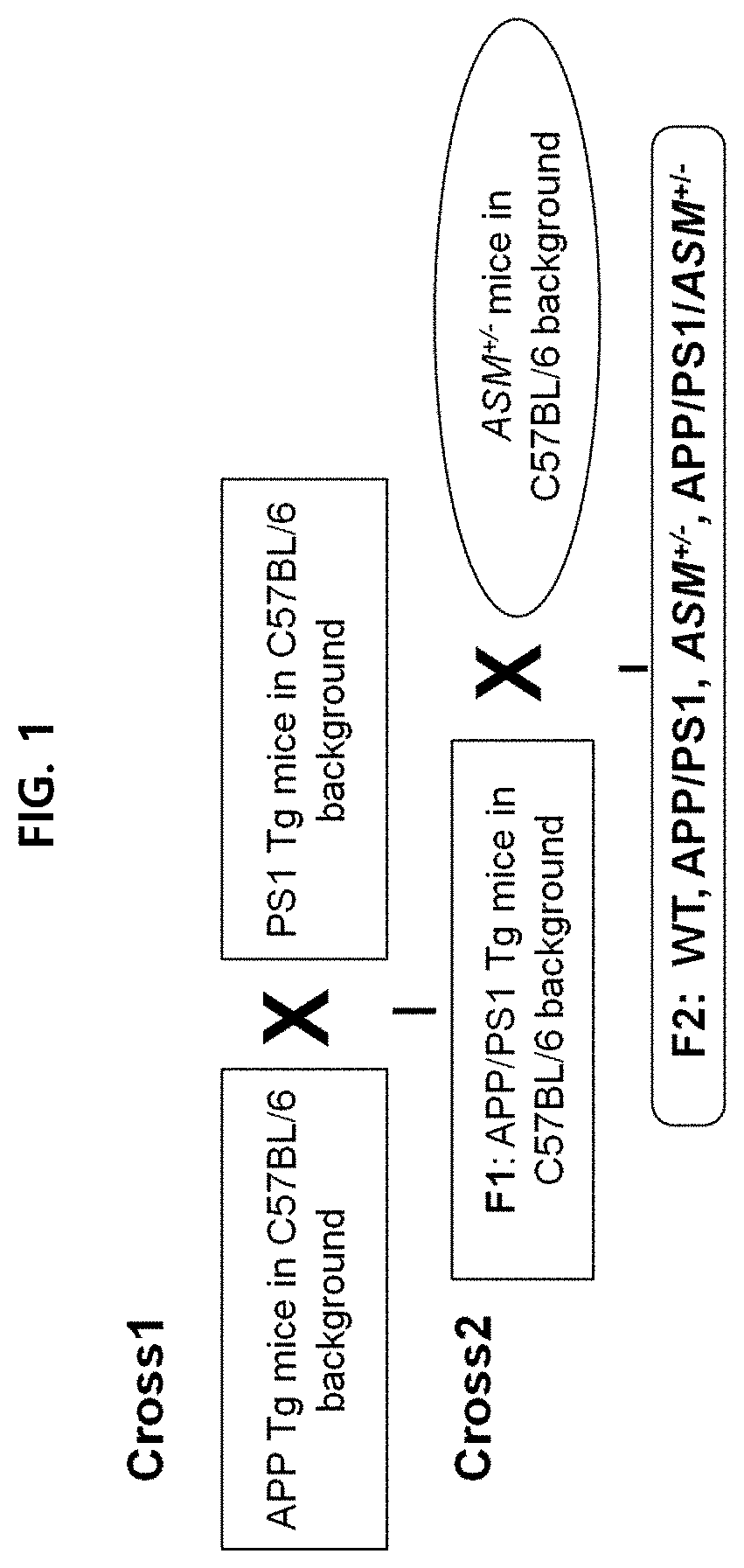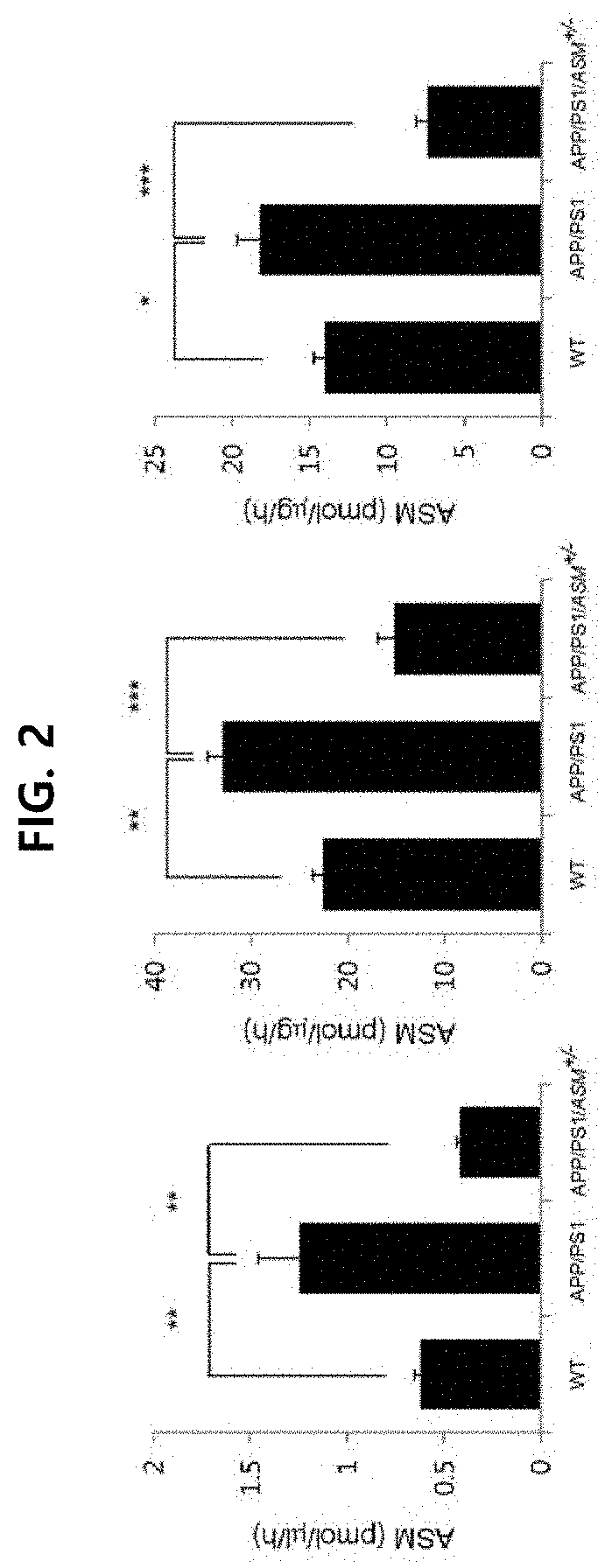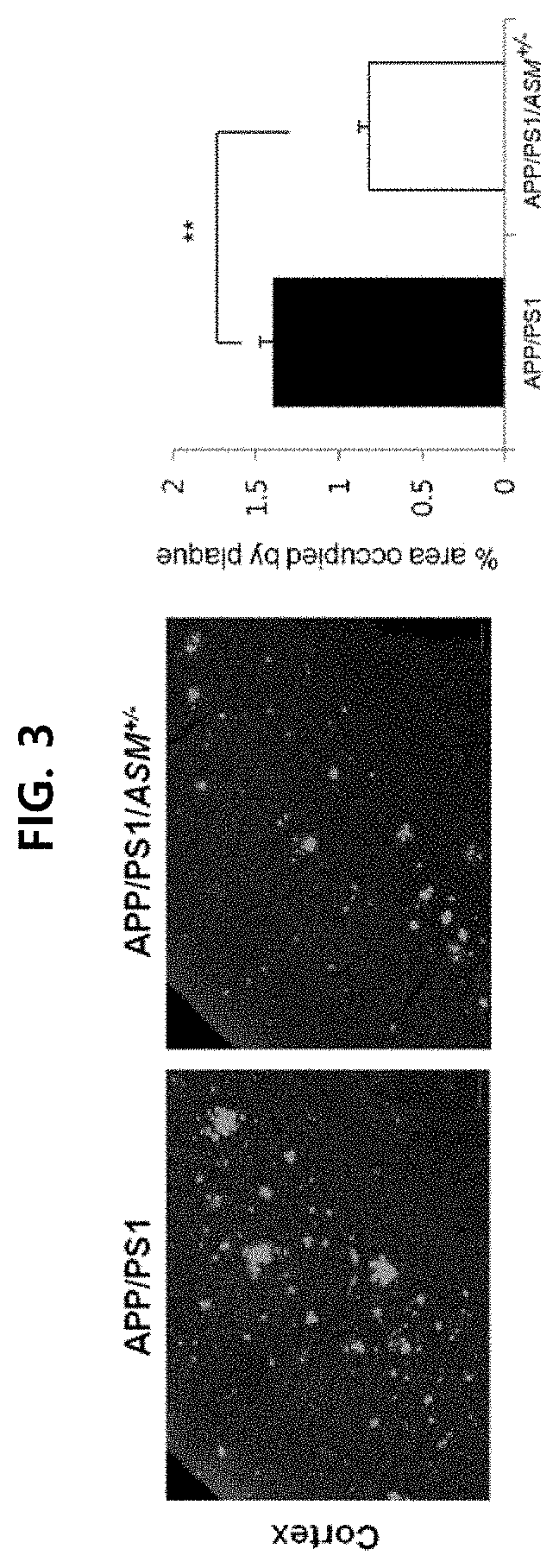Method for treating a neurological disorder comprising administering ASM inhibitors
a neurological disorder and asm inhibitor technology, applied in the direction of enzyme inhibitor ingredients, drug compositions, peptide/protein ingredients, etc., can solve the problems of affecting the development of drugs fundamentally treating the disease or inhibiting the progress of the disease, and temporary relief of symptoms
- Summary
- Abstract
- Description
- Claims
- Application Information
AI Technical Summary
Problems solved by technology
Method used
Image
Examples
example 1
ion on the Effect of ASM Inhibition on the Treatment of Alzheimer's Disease in ASM (Acid Sphingomyelinase) Mutant Mice
1-1. Preparation of ASM Mutant Mice
[0108]An experiment was conducted using APP / PS1 (APP / presenilin) double mutant mice and APP / PS1 / ASM+ / − triple mutant mice (with partial genetic removal of ASM), which are test animal models of Alzheimer's disease.
[0109]The animal test conducted was approved by the Kyungpook National University Institutional Animal Care and Use Committee (IACUC). Transgenic mouse lines overexpressing APPswe (hAPP695swe) or PS1 (presenilin-1M146V) mutations were used onto C57BL / 6 mice (Charles River, UK) [hereinafter, APP mice: mice overexpressing APPswe, PS1 mice: overexpressing presenilin-1M146V; GlaxoSmithKline]. ASM+ / − mice (only one of a pair of ASM genes is removed) were crossed with APP / PS1 mice to prepare APP / PS1 / ASM+ / − mice.
[0110]Detailed process is illustrated in FIG. 1.
1-2. Confirmation on ASM Concentration Level in ASM Mutant Mice
[0111]The...
example 2
ion on Effect of ASM Inhibition on Autophagy in ASM (Acid Sphingomyelinase) Mutant Mice
2-1. Confirmation on Autophagy-Related Gene Expression by ASM Inhibition
[0126]In order to confirm how genetic ASM inhibition works on autophagy-related pathways of Alzheimer's disease, the tail fibroblast and brain tissue samples from nine-month old wild type mice, APP / PS1 mice and APP / PS1 / ASM+ / − mice prepared in Example 1-1 were analyzed.
[0127]More specifically, Western blotting was performed according to a conventional known method using LC3 (rabbit, 1:1000, Cell Signaling Technologies, 4108S), Beclin-1 (rabbit, 1:1000, Cell Signaling Technologies, 3738S), p62 (rabbit, 1:1000, Cell Signaling Technologies, 5114S), cathepsin D (goat, 1:500, R&D Systems, BAF1029) and β-actin (1:1000, Santa Cruz, SC-1615) antibodies, and densitometric quantification was performed using ImageJ software (US National Institutes of Health). The results are illustrated in FIGS. 11 to 14.
[0128]As illustrated in FIGS. 11 t...
example 3
ion on Effect of ASM Inhibition on Autophagy in Human Cell
3-1. Confirmation on Change in Autophagy-Related Gene Expression by Recombinant ASM Protein in Human Fibroblast
[0134]Human fibroblast acquired from the Coriell Institute, and was cultured in DMEM medium containing 15% FBS at 37° C. and 5% of CO2. The cell lines were treated with recombinant ASM (1 μM to 10 μM), and then Western blotting and densitometric quantification were performed in the same manner as Example 2-1. The results are illustrated in FIG. 17 and FIG. 18.
[0135]As illustrated in FIG. 17 and FIG. 18, it is confirmed that conversion from LC3-I to LC3-II takes place depending on the concentration of recombinant ASM treatment, and there is no significant change in expression of beclin-1.
3-2. Confirmation on Mechanism of ASM Using M6P (Mannose-6-Phosphate)
[0136]In order to confirm how ASM affects autophagy, a test was conducted as follows. Human fibroblast was treated with ASM alone, or treated with ASM in the presenc...
PUM
| Property | Measurement | Unit |
|---|---|---|
| pH | aaaaa | aaaaa |
| volume | aaaaa | aaaaa |
| volume | aaaaa | aaaaa |
Abstract
Description
Claims
Application Information
 Login to view more
Login to view more - R&D Engineer
- R&D Manager
- IP Professional
- Industry Leading Data Capabilities
- Powerful AI technology
- Patent DNA Extraction
Browse by: Latest US Patents, China's latest patents, Technical Efficacy Thesaurus, Application Domain, Technology Topic.
© 2024 PatSnap. All rights reserved.Legal|Privacy policy|Modern Slavery Act Transparency Statement|Sitemap



